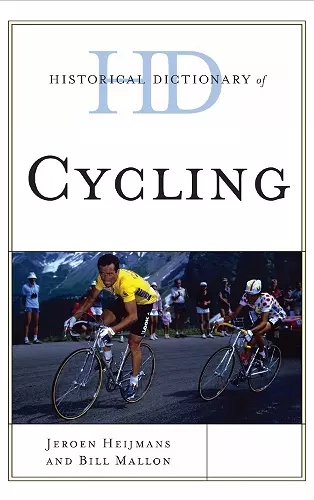Historical Dictionary of Cycling
Bill Mallon author Jeroen Heijmans author
Format:Hardback
Publisher:Scarecrow Press
Published:9th Sep '11
Currently unavailable, our supplier has not provided us a restock date

The nearly 150-year-old sport of cycling had its first competition in France in 1868. Soon afterward, the need arose for purpose-built cycling tracks because of poor road conditions at the time. Racing on blocked off pieces of street or grass soon evolved into racing on special tracks called velodromes. This development marked the split into what are still the two main forms of cycling competition: road racing and track racing. Initially, track cycling was more popular in terms of public attention and money to be earned by racers, but this gradually changed in favor of road racing, which has been the most popular form of cycling since at least the end of World War II. The Historical Dictionary of Cycling takes a closer look at the sport, as well as discussing the use of bicycles as a means of fitness, touring, and commuting. This is done through a chronology, an introductory essay, appendixes, photos, a bibliography, and over 500 cross-referenced dictionary entries on cycling's two main disciplines—road and track—as well as brief overviews of the other forms of cycling. This book is an excellent access point for students, researchers, and anyone wanting to know more about cycling.
This one-volume dictionary, written by two experts on Olympic history, features 500-plus alphabetically arranged entries with cross-references. The length of entries ranges from several lines for a simple definition, to four or five pages, e.g., for the Tour de France race. The breadth of topics is extensive. Individuals, specific races, types of cycling, and topics related to cycling are covered. The book treats controversial issues like doping in a factual, unbiased manner. Overall the writing is readable and concise. Numerous black-and-white photos supplement the text, and ten appendixes list winners in various classes of racing, award winners, and record holders. A chronology of cycling, starting with 1493 and extending to the present, provides interesting reading. A lengthy, topically arranged bibliography will be helpful to those looking for additional information. This monograph will make a good addition to libraries with collections in the history of sports in general or cycling in particular. Summing Up: Recommended. Lower-level undergraduates and above; general readers. * CHOICE *
Historical Dictionary of Cycling provides excellent reference material covering 150 years of cycling condensed in 415 pages. Entries on events, machinery, personalities, chronology, organizations and statistics are clearly laid out and written in an accessible style. The main emphasis is on competitive cycling but there are sections on cycle development and the sociological aspects of cycling. There are also key passages on doping and other current topics exercising discussion by the bodies which govern cycling as a sport....Historical Dictionary of Cycling is, as the cover notes say, “an excellent resource for students, researchers and anyone wanting to know more about cycling”... Ideal for sports reference sections. * s *
ISBN: 9780810871755
Dimensions: 239mm x 162mm x 37mm
Weight: 794g
446 pages